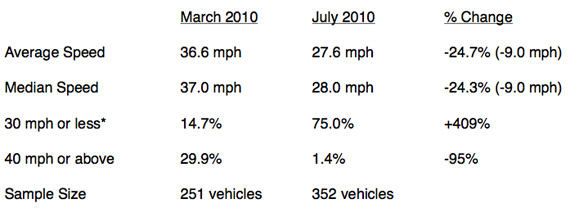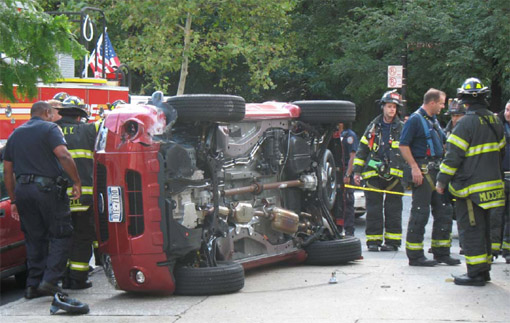Radar Survey Says: New PPW Has Reversed the Curse of Speeding Traffic
 Vehicle speeds recorded on Prospect Park West at the intersection of Garfield Place before and after implementation of the road diet + bike lane. Graphic: Park Slope Neighbors [PDF]
Vehicle speeds recorded on Prospect Park West at the intersection of Garfield Place before and after implementation of the road diet + bike lane. Graphic: Park Slope Neighbors [PDF]The Prospect Park West bike lane has bestowed order and virtually eliminated the raceway conditions on a street where speeding used to be the norm.
In March, before the re-design, the community group Park Slope Neighbors clocked 85 percent of drivers exceeding the 30 mph speed limit on the open expanse of PPW. A post-implementation follow-up last month showed the new street design, with two traffic lanes instead of three, has increased compliance with the speed limit five-fold [PDF]. Average speeds are down about 25 percent.
Each sample was collected by measuring vehicle speeds on two weekend afternoons, when Brooklynites walk and bike in droves across PPW to get to Prospect Park.
Despite the evidence that the traffic-calming plan has worked, Borough President Marty Markowitz hasn’t been swayed, telling the Brooklyn Paper:
Let’s just appreciate this line of thought for a moment: Motorists double-park and spew fumes, so let’s go back to the bad old days when they could double-park, spew fumes, and speed unchecked.
I’d like to see whether Markowitz has any evidence that making it safer for New Yorkers to walk and bike has increased people’s exposure to pollution. Because we know that if you’re walking, biking, or driving on Prospect Park West, this project has drastically reduced your exposure to this kind of vehicular mayhem:
 The sidewalk of Prospect Park West at Eighth Street, September 16, 2006 at 9:45 a.m.
The sidewalk of Prospect Park West at Eighth Street, September 16, 2006 at 9:45 a.m.